Maureen Elenga and husband Robin had been looking for their dream home for nearly two years. So they didn’t hesitate when their realtor told them about an Ira Cummings-designed Mid Century Modern ranch in Seattle coming on the market. “We loved the welcoming smaller entry—it’s the antithesis of a soaring McMansion entry—and the house just fit our personalities,” Maureen says.
The Honeymoon Phase
The 1953 modern ranch sits on Seattle’s Queen Anne Hill with a 190-degree views of Freemont, Lake Union and the distant Cascade Mountains. “It was nighttime when we first saw it, so we didn’t even realize it had a view,” says Maureen. “We put in an offer and had to leave the next day for our wedding,” Robin Elenga, an angel investor, recalls. “Then we were on our two-week honeymoon, which we ended up cutting a week short because we were so excited to see the house. We’d only spent like an hour in there, so we couldn’t quite remember what it looked like.”
They soon discovered mid century gems like a built-in planter and magazine rack in the bathroom, in addition to the built-in birch credenza, the rough-sawn mahogany used for the exterior and the walls of the entry and the memorable sandstone fireplace. A Design Within Reach George Nelson bench next to the fireplace holds stereo gear and a vintage sign for the home’s architect.
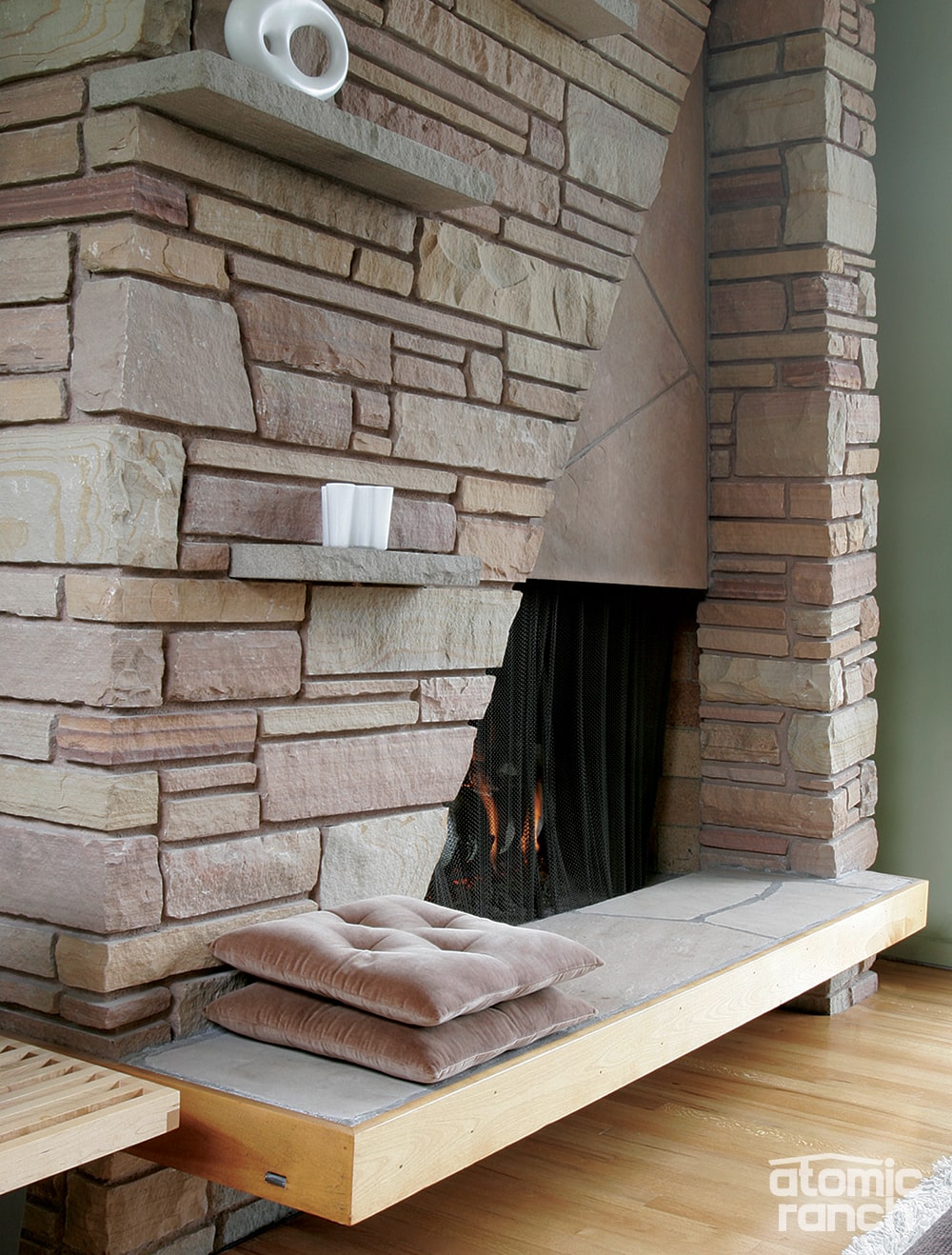
Ira Cummings Architecture
Since buying their own Ira Cummings home, she and Robin have helped organize a DOCOMOMO tour of other Cummings homes. “Ira Cummings’ other residences tend to do the sort of head and tail formula, with public spaces at one end, and it functions really well,” she says. “He emphasized the hearth as the center of the home, and his fireplaces are large and very interesting.
“Like many Pacific Northwest architects, he used a lot of natural materials like the stone and mahogany; that’s what differentiates the PNW modernists. They took a lot of cues from Japanese architecture as well. Being in the living room with all of the windows and that view, it’s like being in a tree house.”
Getting the Lay of the Land
The home had last been sold in 1965 and was in remarkably original condition, save for a 1981 kitchen and a master bedroom/bath addition and carport-to-garage conversion in 1989.
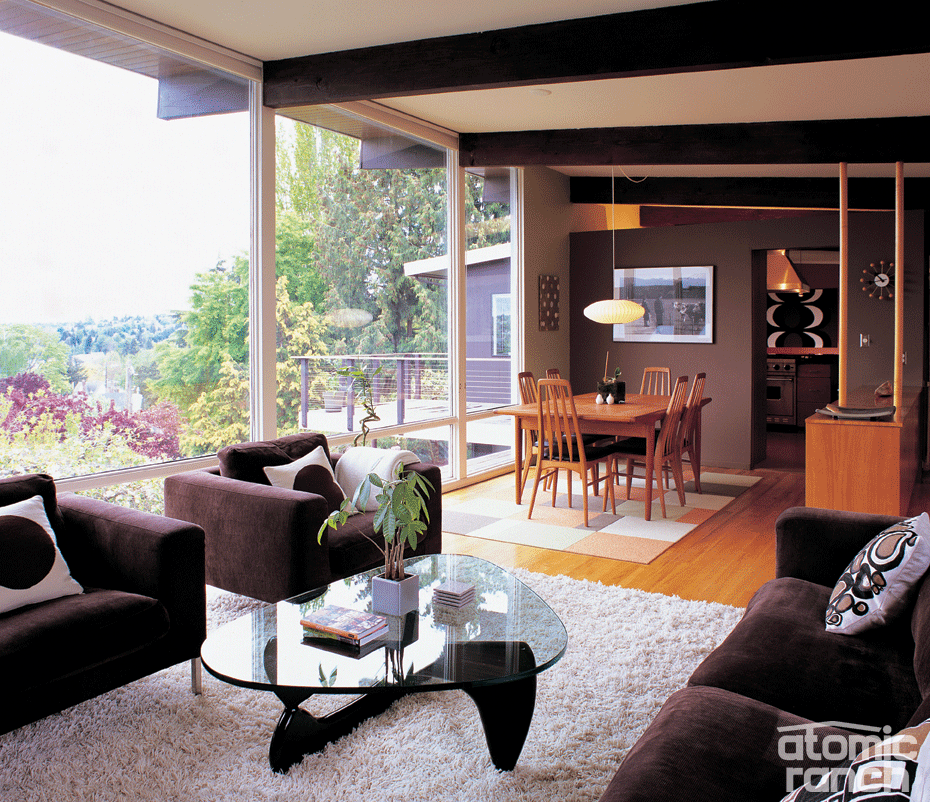
Seattle’s Queen Anne neighborhood is better known for Arts and Crafts cottages and the namesake 1880s Victorians. Elengas’ street and those nearby mostly feature bungalows, cottages, some 1980s and ’90s infill and a few houses ripe for teardown. Somewhat surprisingly for an architectural historian, Maureen doesn’t mind the handful of new homes that are popping up in place of original structures.
“I think it’s a good thing as long as they stay within the scale of the other houses,” she says. “I like variety and I think the mix makes the street more interesting. There are other people who see a modern house going up and say, ‘It just doesn’t fit in.’ I think, with what? There’s no architectural continuity on this street.” This mixture of housing styles gave the Elengas family the go ahead to do any renovation they desired.
Let the Renovation Begin
The structure of the Seattle Ira Cummings ranch already fit their family needs. As the author of Seattle Architecture: A Walking Guide to Downtown and mom to preschoolers Sofia and Otto, Maureen finds the house particularly suited to their current lifestyle. “We had in mind we’d be raising a family here. The scale of the rooms is more conducive to family life—it’s more intimate. And the layout makes it so we’re not all crammed together; it flows well. “I grew up in a 4,500-square-foot house my dad designed,” she notes. “It was a great ’70s contemporary, but I don’t think I’d want to clean 4,500 square feet.”
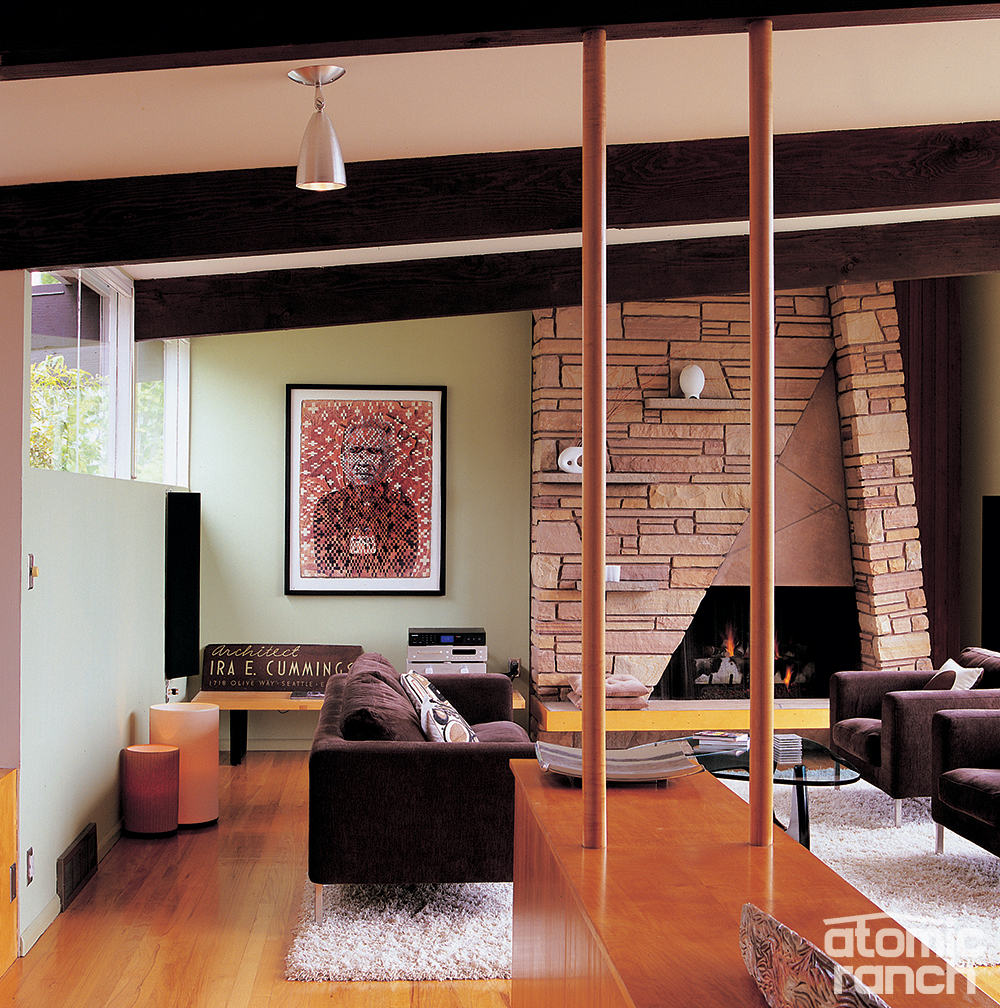
Robin and Maureen refinished all of the wood in the house, including the floors on the main level. They painted inside and out and installed cork floors in one bath, northwest room and the kitchen. Of the two styles of similarly priced cork flooring, the natural tiles that are glued in place and finished with a wax coating have held up very well. The pre-finished, floating, thin-cork-layer-on-top-of-two-substrates version has not, Robin reports.
They also took down a wall that created an awkward space off the kitchen. They swapped out a window for a glass door that leads to a new deck. The Nelson CSS unit in the opened up hallway-cum-kitchen office has become a family computer station and is one of the most used areas of the house.
Robin, who’d renovated two bungalows previously, crafted a long, low media storage unit for the downstairs family room. He recessed the electronics into the space between the wall studs so the unit has a slim profile and all of the wiring is hidden.
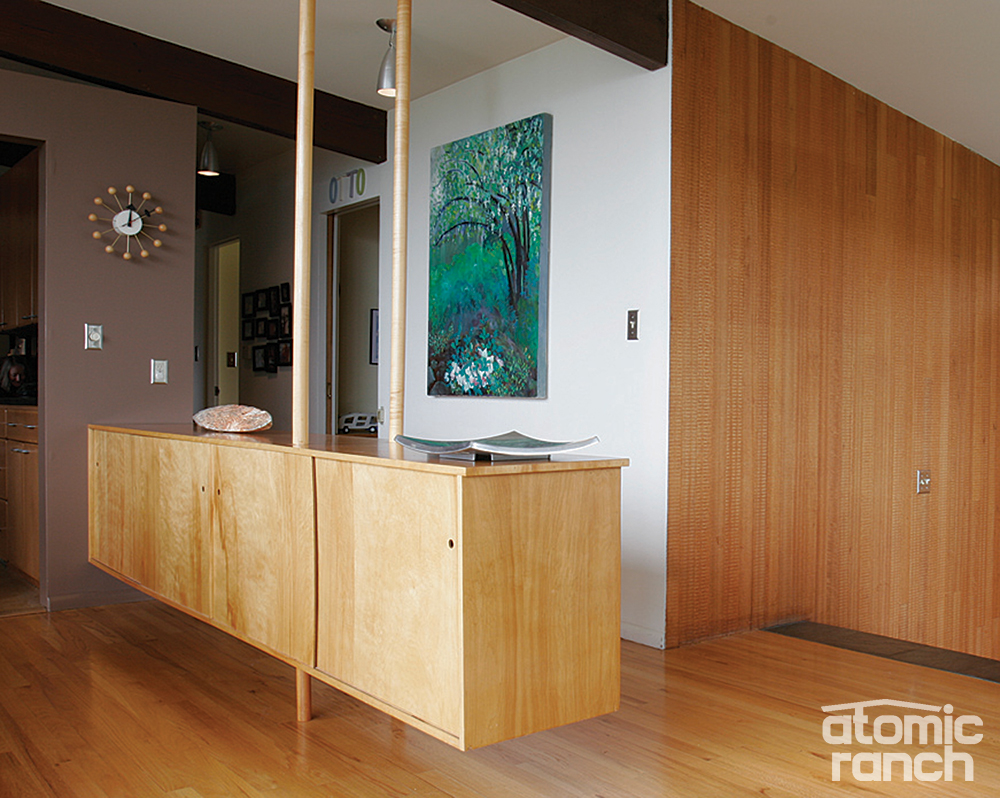
Renovation Snags
To their dismay, there was a challenging renovation still ahead—the re-plumbing project of their retro bathroom. “I thought it would take me two days, but it ended up taking eight,” Robin recalls. “All of the pipes seemed to come together in the small bathroom in the basement—there were about 50 solder joints in just that room.
“Surprisingly, there were no leaks when I was finished and we got it done just in time for some visitors. Then I learned about PEX tubing (flexible plastic tubing with joints that you slip on); I could have done it all in two days with that stuff.” The Elengas also removed pickled knotty pine paneling from the daylight basement and dry walled and skim coated the surfaces.
The downstairs bath had a pink sink and tub, so they went all in with a retro pink and black theme. The pink fixtures and harlequin floor are original features in their retro bathroom. In addition to the large family room/office, there’s also a guest room down below. Upstairs are two baths and three other bedrooms. One last surprise was discovering that two weeks in the summer the kids’ bedrooms were uninhabitable, so they had a Puron A/C system put in.
Yet to Come Renovations

“When we bought the house, we were happy so many of the built-ins and the woodwork were left original. But we still have to remodel the master bath and the kitchen— those will be big projects,” Maureen notes.
Maureen’s working with her interior designer sister on the kitchen. They will keep some elements—including the pocket door that closes the room off from the dining room—and improve on others.
“I’d like cabinets that match the credenza and a six burner cooktop, but otherwise would like to make it look more original,” Maureen says.
“Some Mid Century Modern homeowners are strict about wanting appliances that are or look vintage. That’s fine, but I think if you have cabinets, counters and backsplashes that are true to the era, it’s OK to switch in new stuff.”
What with Maureen’s training as an architectural historian and having an architect father and brother, it’s only fitting that the Elengas ended up with an Ira Cummings Seattle ranch. “I loved these houses long before they came into fashion.”
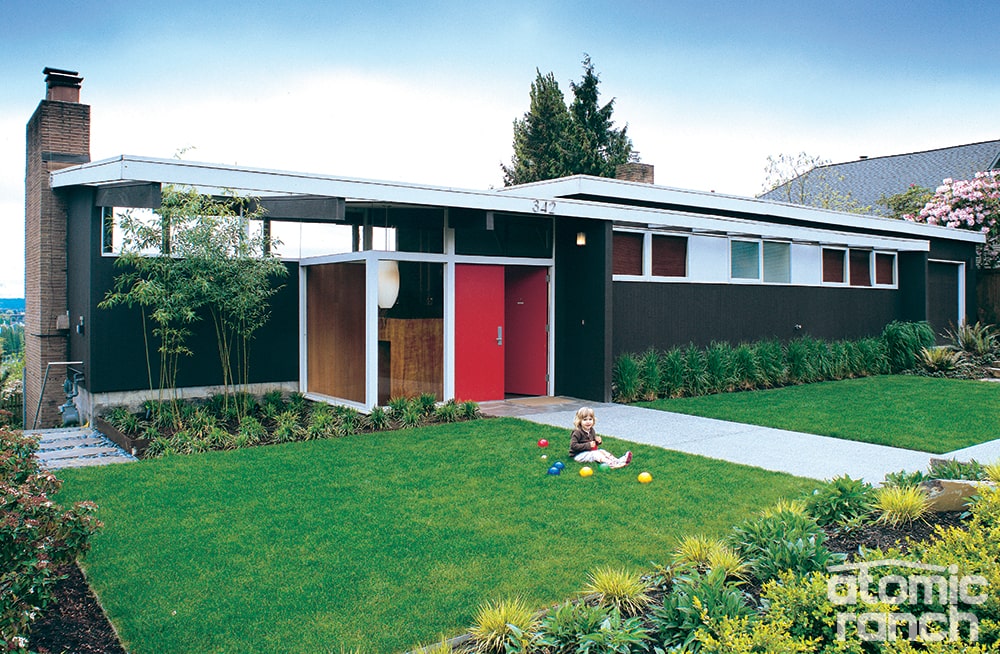
Love the blend of stonework and Japanese influence in Pacific Northwest modernism? Don’t miss “Zen Meets Mod in This John Burrows Seattle Mid Century.” And of course, don’t forget to follow us on Instagram, Facebook, Pinterest and YouTube for more Atomic Ranch articles, house tours, and ideas!













1 comment